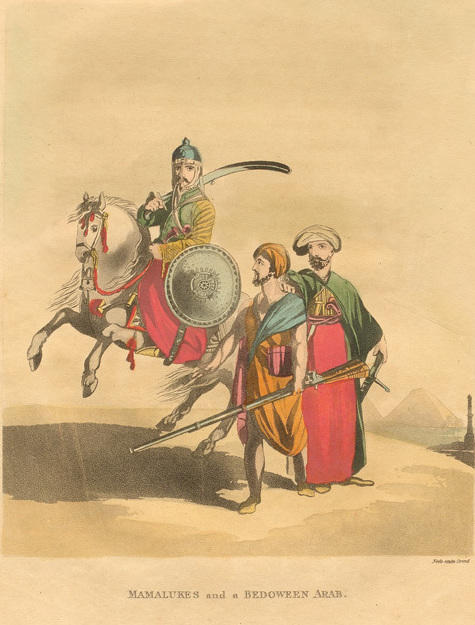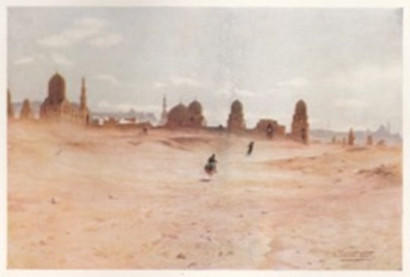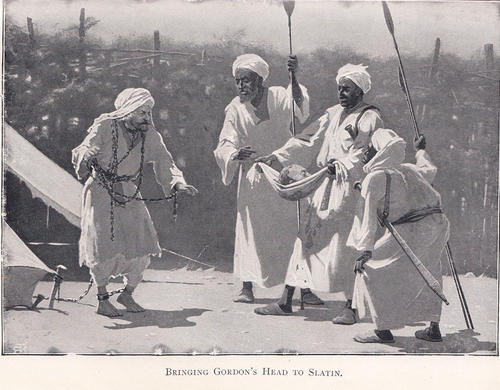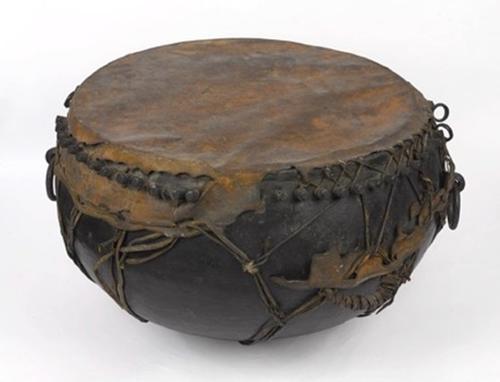British and French Soldiers in Egypt and the Levant, 1798-1920: Introductory Text
by Paul Fox & Fergus Robson
The French and British armed forces were involved in four conflicts on Egyptian territory between 1798 and 1918, all of which stimulated metropolitan interest in the region. European cultural producers in Egypt and at home represented significant events, the landscapes of the Nile valley, the daily lives of Europeans at war, and of Egyptians too.
The arrival of a French fleet carrying 38,000 troops in 1798 marked the point of departure for a new, intensive phase of European engagement with Egypt. Bonaparte and the Directory regarded Egypt as a staging post for the planned overland invasion of British possessions in India. The cultural resonance of Classical Egypt in Enlightenment France led to the deployment of a team of 160 artists, scientists, engineers and mathematicians (the savants) alongside the military component of the expedition.
After taking control of Alexandria, the army penetrated Lower Egypt so swiftly that General Dupuy could write that ‘in just fifteen days we have conquered yet another province of the Roman Empire’. The subsequent British naval victory at Aboukir Bay however, isolated the expedition from mainland France and checked French ambitions.
Over the course of the next three years the French army nevertheless launched an invasion of Syria, and repressed two major revolts in Cairo, as well as innumerable lesser uprisings. They fought against Ottoman and English armies, and experienced less conventional confrontations with Jihadi warriors, and were harassed by Bedouin raiders. Bonaparte set up a Divan, or governing council, to rule on issues of law, reformed the taxation system, used Arabic printing presses to issue proclamations, and proposed Europeans models for agriculture and industry in order to ‘modernise’ what was understood by Europeans to be a backward country.
The savants sketched antiquities and scenes of daily life in contemporary Lower Egypt. Their output was published in the series La Description de l’Égypte (1809—29), and, together with Vivant Denon’s 1803 Voyage dans la Basse et la Haute Égypte, influenced the popularisation of images and ideas of Egypt and the Orient in France and beyond.
Like their British opponents, many officers and other ranks kept journals and retained their unsent letters. They subsequently wrote memoirs later in life, told stories, and sang about their time in Egypt. Some of them learned Arabic, some converted to Islam, many bought food, trinkets and sex. The sum of their cultural production offered European reader-viewers a rich array of representations of life past and present on the other side of the Mediterranean. In France cashmere shawls and Egyptian motifs became fashionable. Turbans and scimitars became props in plays, hieroglyphs fascinated the educated, and false hieroglyphs even appeared on military decorations.
Britain too was drawn by Napoleon into a close encounter with Egypt. Naval success at the Battle of the Nile culminated in a ground war to expel the French army involving over 22,000 troops between 1801 and 1802. Five years later an expeditionary force was despatched to take and hold Alexandria. During these operations officers produced sketches of significant terrain. Some of this work had military utility as visual aids to planning and the application of firepower. But amateur soldier-artists also sketched what they considered significant in a wider sense, including ancient ruins and a quotidian life unlike their own. Back in Britain, some of this work was used as source material by professional artists commissioned to produce battle paintings, by others with a commercial interest in producing engravings for a wider market, and for the production of panoramas. Egypt became newly visible in Britain, too.
R. Talbot Kelly, A Dusty Day at the Tombs of the Khalifs, in: Egypt Painted and Described (1906)
Image Credit: personal collection, photo: Paul Fox
Robert Talbot Kelly, Bringing Gordon's Head to Slatin, in: Rudolf Carl von Slatin, Fire and Sword in the Sudan (1895)
Image Credit: personal collection, photo: Paul Fox
European writers, artists and academics responded to demand throughout the nineteenth century for works offering insights into Egypt past and present. The Nile valley became a popular destination for European travellers, who consulted guides and brought home souvenirs. Egypt’s ruins were sketched, painted, written about, and photographed intensively by cultural producers capitalising on their commercial potential.
In 1882 a joint Royal Navy and Army expeditionary force was dispatched to check the ambitions of Egyptian nationalist Ahmed Urabi, restore the established political order, and secure British interests in the region. The campaign was short, but the British victory at Tel-el-Kebir resulted in a British military presence in the Nile Delta that was to last 74 years. The subsequent circulation of war trophies, loot, and souvenirs, as well as campaign memoirs, maps, topographical sketches, battle paintings, and soldiers’ drawings of the people and places they encountered, ensured that Egypt was once again prominent in British metropolitan culture.
In Egypt itself service was to prove a lot more challenging than merely maintaining a credible force posture on the Mediterranean littoral while training a new Egyptian army on behalf of a well-disposed government. In 1881 Sudanese religious leader Muhammad Ahmad pronounced himself Mahdi—the prophesied redeemer of Islam—and declared Jihad against the Egyptian administration of the Sudan. The resulting counter-insurgency campaign lasted until 1899. Fought under British control, British officers led Egyptian and Sudanese soldiers in the field, sometimes alongside British formations.
The campaign included some of the most hard-fought military episodes of the era. Popular interest in operations in Egypt peaked when General Charles Gordon was killed by besieging Mahdist forces at Khartoum in January 1885. The Nile Expedition may have been a conspicuous failure, but in the telling it was framed as a military epic featuring feats of steadfast endurance and vainglorious sacrifice. Dervish warriors were represented as the most worthy of ‘barbaric’ opponents, whose actions were set against the ‘exotic’ backdrop of the Nile valley. Egypt and its history was positioned at the epicentre of an imperial epic. A material culture developed that navigated British self-regard with reference to the character of local people encountered as friends or foe. It was in these circumstances that another generation of soldiers and sailors returned home with souvenir objects, battlefield trophies, songs, stories, and draft autobiographical manuscripts.
Drum, captured by Dervish forces from Hick's 1883 expedition, recovered during Dongola expedition (1896)
Image Credit: © NAM, London, England
Nor did the French memory of Egypt recede; a raft of rediscovered memoirs were published in the latter half of the nineteenth century. Egypt was not just a lieu de memoire however; French investors and engineers funded and designed the Suez Canal. And, a hundred years after Napoleon’s troops landed in Egypt, another expedition on the Nile saw France and Britain veer towards war during the Fashoda Crisis: a clash over French colonial pretentions in Upper Egypt that once more insinuated the Land of the Pharaohs into French consciousness.
During the First World War Egypt was a British protectorate. Its territory acted as a staging post and training ground for military formations drawn from across Britain’s empire. Operations in Sinai and Palestine to the east, the Western Desert towards Libya, and the Eastern Mediterranean and Suez Canal, pivoted around the conurbations of the Nile delta. By 1918 there were 400,000 troops in the area. Off-duty British and Colonial servicemen and women took advantage of Egypt’s recreational opportunities, just as their predecessors had. Another generation of soldiers and sailors returned home with souvenir objects, battlefield trophies, songs, stories, drawings, photographs, and literary accounts of their experiences. For over a century things Egyptian, encountered as a result of war fighting in the region, were privileged in European material culture, shaping the understanding of what a cultural encounter might amount to in the European imagination.
Bibliography
- Z. Abul-Magd, Imagined Empires: A History of Revolt in Egypt (Berkeley, 2013)
- I. A. Bierman, ed. Napoleon in Egypt (Reading, 2003)
- Brian Bond, Victorian Military Campaigns (London: Hutchinson, 1967)
- Caroline Brothers, War and Photography, a Cultural History (London: Routledge, 1997)
- Deborah Bull, and Donald Lorimer, Up the Nile : A Photographic Excursion, Egypt 1839-1898 (New York: Clarkson N. Potter, 1979)
- J. Cole, Napoleon’s Egypt: Invading the Middle-East (Basingstoke, 2007)
- I. Coller, Arab France: Islam and the Making of Modern Europe, 1798-1831 (Berkeley, 2011)
- Annie E. Coombes, Reinventing Africa: Museums, Material Culture, and Popular Imagination in Late Victorian and Edwardian England (London: Yale University Press, 1994)
- David Crouch and Nina Lubbren, ed., Visual Culture and Tourism (Oxford: Berg, 2003)
- Graham Dawson, Soldier Heroes: British Adventure, Empire and the Imagining of Masculinities (London; New York: Routledge, 1994)
- J. W. M. Hichberger, Images of the Army: The Military in British Art, 1815-1914 (Manchester: Manchester University Press, 1988)
- Holger Hoock, Empires of the Imagination: Politics, War and the Arts in the British World, 1750-1850 (London: Profile Books, 2010)
- M. Jasanoff, Edge of Empire: Conquest and collecting in the east, 1750-1850 (London, 2006)
- David Jeffreys, ed., Views of Ancient Egypt since Napoleon Bonaparte : Imperialism, Colonialism and Modern Appropriations (London: UCL Press, 2003)
- H. Laurens, L'Expédition d'Egypte, 1798-1801 (Paris, 1989)
- Fred R. Myers, ed., The Empire of Things: Regimes of Value and Material Culture (Santa Fe, N.M.: School of American Research Press; James Currey, Oxford, 2001)
- M. L .Pratt, Imperial eyes: Studies in travel writing and transculturation (London, 1992)
- Edward M. Spiers, ed., Sudan: The Reconquest Reappraised (London: Frank Cass, 1998)
- P. Strathern, Napoleon in Egypt; the greatest glory (London, 2007)
- E. Said, Orientalism (London, 1978)
- J. Urry and J. Larsen, The tourist gaze 3.0 (New York, 2011)
Citation
Fox, Paul/Fergus Robson: British and French Soldiers in Egypt and in the Levant, 1798—1918. Introductory Text to the Exhibition of www.mwme.eu (2015), URL: http://www.mwme.eu/essays/index.html
---
---





